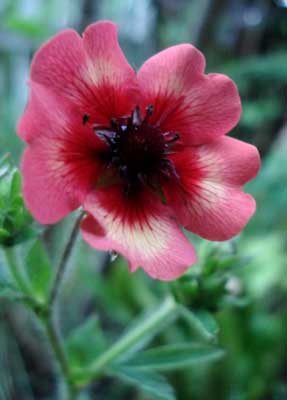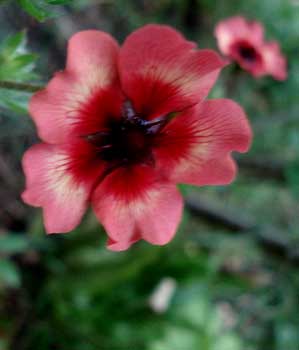
'Miss Willmott'
Nepalese Cinquefoil; aka,
Five-Finger Potentilla
"A light foot treads the fragile bowers,
Two slender hands are filled with flowers,
A fair face all aglow;
To round, red cheeks a dimple slips,
In liquid eyes the glad light dips,
She loves her garden so!"
-Elaine Goodale Eastman
(1863 - 1953)
(1863 - 1953)
Potentilla nepalensis 'Miss Willmott' (aka, 'Willmottiae') grows in the roadside sun-garden, a dark pink cinquefoil resembling a strawberry plant, red-flowering & blood-black at the very heart.
It is semi-prostrate & reaches its branching flower stems two or three feet in all directions for a considerable spread away from the core clump. Since ours lives amidst much taller echinaceas & other upright sun-perennials, it weaves about & between these, sending flowers upward at intervals.
An established clump is more than commonly drought-hardy but blooms more thrillingly if given moderate watering in perfectly draining light/poor to moderately rich soil. It blooms from June to first frost or later, & if at any point through that long period the flowers seem to be less numerous, clipping the wandering branchings of stems re-sets it's bloom-like-mad buttons.
 'Miss Willmott' is named for the English gardening fanatic Ellen Ann Willmott (1860-1934). She was the wealthy patron of Alfred Parson, whom she commissioned to provide botanical paintings of the specimens in her rose garden.
'Miss Willmott' is named for the English gardening fanatic Ellen Ann Willmott (1860-1934). She was the wealthy patron of Alfred Parson, whom she commissioned to provide botanical paintings of the specimens in her rose garden.These watercolors illustrated her two-volume overview of The Genus Rosa (1910, 1914), which on the open market is today worth about $2,000 to $4,000, or even more. After Ellen's death, the Alfred Parson paintings went into Lindley Library at the Royal Horticultural Society in London. In 1987 with the support of the RHS, a splendidly reproduced volume of all these watercolors was issued as A Garden of Roses.
At the height of her enterprises she had from eighty to over a hundred full-time gardeners who shipped seeds all around the world for other gardeners. Besides her main gardens at Warley Place in Essex, she had additional gardens in France & Italy, & especially throughout Essex, many a garden to this day owes a debt to the hundreds of strains developed at Warley. A book issued in 1909, Warley Garden in Spring & Summer, includes thirty photogravure plates that reveal the exellence of Ellen's gardens in their heyday before the first world war.
She was a short-tempered nutter who berated her army of gardeners if she spotted even a single weed, so the seeds of insipient madness would seem to go along with privilege. After the War, with the loss of her wealth, her gardens feel into decline, & what for the wealthy is called eccentricity for the impoverished is admitted to be insanity.
She went about the village shoplifting, a nuisance to all, & her unwanted behavior triggered an unutterable paranoia. She spent the last of her ambulatory days laying booby traps all about her gardens, to catch imaginary enemies.
By the time of her death in 1934 she lived in but three rooms of her largely boarded-up & mouldering manse, & her gardens were left to become their own wilderness. In 1978, the remnant of her gardens, known today as the Warley Place Wild Garden, became part of the Essex Naturalists Trust.
 Two surviving gardens today on the English Heritage Register have her hand in their design. One is Spetchly Park Gardens in Worscestershire which she orchestrated with her sister Rose who married into the estate. The other is Lotherton Hall Gardens in West Yorkshire.
Two surviving gardens today on the English Heritage Register have her hand in their design. One is Spetchly Park Gardens in Worscestershire which she orchestrated with her sister Rose who married into the estate. The other is Lotherton Hall Gardens in West Yorkshire.This cultivar is but one of the many plants named for her, either species names or cultivar names. 'Miss Willmott' cinquefoil is a wee bit sensitive its first year in the ground, but is thereafter hardy & drought-tolerant.
It is very free-blooming once established; it can easily flower continuously from June to September, at the minimum. If it does stop blooming toward the end of summer, a good shearing will induce it to send up more upright stems, & flower again for autumn. Season-end shearing also keeps it from becoming increasingly sprawly & leggy.
Hardy to the point of weediness in zones 7-8, it can succeed with varying degrees of tenderness in zones five through ten, though bloom time will be briefer in colder zones. It requires organically rich extremely well-draining soil, & does not thrive in wet or clayey soils. It prefers full sun but may require a tiny portion of shade in hotter zones. Seasonal fertilizing with an evergreen fertilizer isn't essential, but can benefit especially a clump that is in a crowded perennial garden.
The genus name means "Potent" or "Powerful," because it has been believed to be a potent medicinal plant. Nepalese potentillia is used in the Western Himalayas, from Nepal to Pakistan, to treat burns, & for other uses, though efficacy is to date unproven. The starchy root is also regarded as edible, in a pinch.
See also:
Potentilla thurberi maorubens 'Monarch's Velvet'